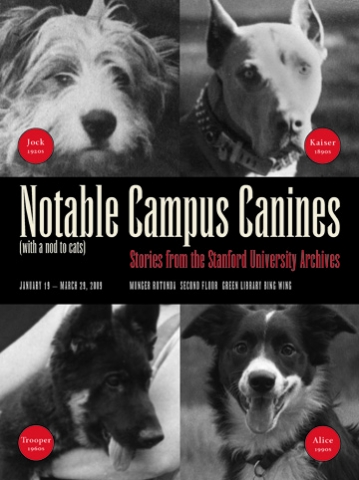 From its origins as a stock farm in the 1870s to the dog-friendly offices of the HighWire Press in the 1990s, the Stanford campus has long provided a habitat for man's best friend. The exhibition Notable Campus Canines (with a nod to cats): Stories from the Stanford University Archives, curated by archives specialist Patricia White, explores the issue of pets on campus through stories of notable dogs--and some of their notable masters--told with accompanying photographs, correspondence, and printed sources from the Stanford University Archives. The exhibit runs January 19 - April 5, 2009 in the Munger Rotunda of Green Library, Stanford University.
From its origins as a stock farm in the 1870s to the dog-friendly offices of the HighWire Press in the 1990s, the Stanford campus has long provided a habitat for man's best friend. The exhibition Notable Campus Canines (with a nod to cats): Stories from the Stanford University Archives, curated by archives specialist Patricia White, explores the issue of pets on campus through stories of notable dogs--and some of their notable masters--told with accompanying photographs, correspondence, and printed sources from the Stanford University Archives. The exhibit runs January 19 - April 5, 2009 in the Munger Rotunda of Green Library, Stanford University.
Notable canines in Stanford history include Kaiser, a Great Dane of Viennese lineage who belonged to the Stanford family; Jock, an Old English Sheepdog whose intelligence and devotion is the subject of letters and photographs in the papers of the university's first president, David Starr Jordan; Trooper, a German Shepherd who underwent successful heart surgery at Stanford Medical Center in 1966; and Alice, a Border Collie who has held an honorary position as "lead dog" of the team at the University Libraries' HighWire Press since the mid-1990s.
Large-format photographs of dogs in familiar campus settings from the portfolio of San Francisco photographer and Senior Lecturer of Photography, Emeritus, Leo Holub--best known for the Anderson Collection portraits of artists in their studios--provide glimpses of a dog's life at Stanford in the late 1960s, a period during which the leash law was largely ignored. The problem of stray dogs running loose to the detriment of public safety is highlighted through news clippings, administrative memos, complaint records, and photographs from the early 1970s, when a black-and-white shorthair named Oscar became a poster dog representing the dubious right of his species to roam free.
A similar problem involving the proliferation of non-neutered abandoned cats on campus led to the founding of the Stanford Cat Network, which became a nationwide model for humane control of feral cat populations, and celebrates its twentieth anniversary this year. In a nod to cats, a section of the exhibit is devoted to the story of how the Stanford Cat Network came about.
The exhibition is free and open to the public. Exhibit cases are illuminated Monday through Friday from 10 a.m. to 6 p.m., Saturday from 10 a.m. to 5 p.m., and Sunday from 12 to 6 p.m. The Peterson gallery is accessible whenever Green Library is open, but library hours vary with the academic schedule. For current hours, call 650-723-0931.
NOTE: first-time visitors must register at the south entrance portal to Green Library's ease wing to gain access to the library. For a map of campus and transportation information, go to http://www.stanford.edu/dept/visitorinfo/plan/maps.html.